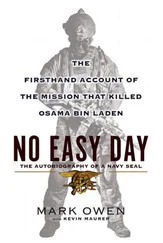“Seven weeks,” I said. “Sign me up.”

CHAPTER 2
How to Swim Fifty Meters Underwater Without Dying
Confidence
Ice floatedin the water outside of my hotel window as I zipped my dry suit shut.
I’d been staring out of the window off and on since we’d spotted the bloody sea lion carcass on the shore that morning. The sea lion’s body had a huge gash in its side, and the ice around it was bloodred. A killer whale did it, or that is what the locals told us. I would have appreciated the scene more, but in less than an hour, my SEAL teammates and I were about to get in the same water to plant a bomb on a U.S. Navy ship.
I took some solace in the fact that at least the killer whale had a full stomach.
I was a brand-new SEAL, having graduated BUD/S just nine months earlier, and it was cool to be back in Alaska training. The scenario was pretty simple. My SEAL platoon got tapped to play the OPFOR—military jargon for “opposing force,” or the bad guys. It was our job to attack an amphibious assault ship moored at the pier in Ketchikan, Alaska. We had to sneak in close enough to the ship to set tracking devices. Some of the ship’s crew as well as a small contingent of Army soldiers would be guarding the ship and surrounding areas. Their task was to defend against a threat like us.
There was a foot of snow on the pier and the water temperature was hovering just above freezing as we prepared. I smeared black paint on my face and squeezed all of my warm clothes under my dry suit.
One of my teammates knocked on my door, and I grabbed the rest of my gear and headed out. We met in the parking lot of our hotel and the four of us on the OPFOR assault team—all dressed in dry suits and painted faces—climbed into the back of a U-Haul truck. We were the brand-new guys in the platoon.
If the dark, cold water and the seal-eating killer whales weren’t scary enough, we also had to worry about Flipper, a killer dolphin stalking us from the deep.
I’m not kidding.
The Navy has bottlenose dolphins trained to attack divers. The dolphins were part of the U.S. Navy Marine Mammal Program, which trained both dolphins and sea lions to detect mines and protect harbors and ships. Both the United States and Russia spent millions on these kinds of training programs, and the dolphins were used in combat during the Gulf War and in operations off the coast of Iraq. The Russian program was disbanded in the late 1990s, and word was their killer dolphins were sold to Iran.
The Navy had flown three dolphins up to Alaska from San Diego in heated tanks so that they could hunt us. One dolphin was stationed in a cage at each end of the ship that was our target, and the third was free-swimming. The dolphins in the cages were trained to use their sonar to detect divers. When they heard us coming, the dolphins were supposed to surface and ring a bell attached to the cage. The dolphin handlers would then call in via radio that the dolphin had heard something, and the patrol boats would come looking for us.
When the free-swimming dolphin spotted a swimmer, it attacked, forcing the diver to the surface. We had to deal with a giant dolphin swimming full speed in the dark water repeatedly bashing us with its nose until we swam to the surface. It’s no fun heading into icy, pitch-black water in the dead of night under any conditions, but the constant possibility of a giant dolphin ramming you at full speed added a little anxiety to the mission.
A few hours before we hit the water, two of my teammates in plain clothes had made their way along a nearby dock with a pair of dive tanks. When they got near the ship, they opened the valves at the top of the tanks, allowing just enough air to escape to make bubbles. My teammates tied the tanks together and dropped them over the side of the pier, lashing the anchor line to the rail before they walked away. The bubbles were white noise underwater to cover our approach.
With the tanks in the water, we left the hotel and headed toward the river that ran from the town to the channel. We bounced along the rutted roads of Ketchikan in the back of the U-Haul. I could hear our equipment rattle as tanks banged against the wall. No one spoke. I was nervous. I wasn’t the best swimmer, and navigating underwater in pitch-black darkness while hunted by a killer dolphin wasn’t going to be easy. But it wasn’t the dolphins or the killer whale that scared me the most. It was the swim to the ship.
Much of the town was built on a wooden dock where the ship was moored. The conventional approach would have been to swim out in the main channel, which is where the dolphins were stationed. We had decided to sneak in from under the immense pier network. If we came in from the river, the large stanchions holding the pier together would mask our movement. But that also meant we’d be swimming in complete darkness through a maze of pylons and debris. We couldn’t use flashlights for fear of attracting the dolphins below or the guards patrolling the dock above us. We would have to silently feel our way from pylon to pylon. This swim was going to be all by touch, as we worked our way through the water.
The truck coasted to a stop and we could hear the driver—another teammate—talking to a security guard. My heart rate kicked up and we held our collective breath. If they searched the truck, the mission was done. We sat for only a few seconds, likely because of traffic backed up at the checkpoint, but it was a very long few seconds. At last I could hear the engine roar as we headed to the bank of the creek.
I felt the truck slow and then stop. The driver cut the engine and seconds later threw open the back door. I climbed out of the truck with the other three divers and trudged through the snow to the water.
We got into pairs and attached a line to each other so no one would get lost. I would never be more than four feet apart from my swim buddy. We waded into the water. I took two long and slow deep breaths, put in my regulator, and slipped into the creek. With our goggles on and dive rigs ready to go, we gave each other a quick thumbs-up and began submerging ourselves in the frigid water. I had to stifle a gasp as the ice-cold water washed over my head and face. In seconds it was pitch-black.
“I hate diving,” I thought.
I was nervous. This was one of my first missions—it was training, but we were in an uncontrolled environment and the dangers were real—and I wasn’t completely comfortable in the water. I knew being a SEAL meant underwater operations, but I dreaded them. The water portion of BUD/S was hard for me. The long runs and push-ups during BUD/S never worried me, but the water tests did. I wasn’t a surfer. I wasn’t really a swimmer. I had never done a lot of swimming as a kid in Alaska.
I can remember my dad challenged me once when I was almost a teenager to swim across the river in front of our house. The current pushed against me as I slowly swam. By the time I reached the far bank, I was a quarter of a mile downriver from where I’d started. That was the farthest I’d swum before I started training for BUD/S. When it came time to pass the fifty-meter underwater swim during BUD/S, I had the same nervous feeling as I had getting ready to dive under the dock in Alaska.
The fifty-meter underwater swim is one of the first pass-or-fail tests during BUD/S. I remember it was a sunny day in June, the clouds having burned away to reveal a blue sky. The pool was across from the BUD/S training area on Naval Base Coronado, which sits across the bay from San Diego.
My BUD/S class ran over to the pool in the morning. We’d already spent hours in the cold surf doing flutter kicks and running for miles in the sand. We all knew the test was coming, and there was a nervous energy up and down the ranks. We crowded on one side of the pool in our tan shorts, shirtless and barefoot, and listened to the safety brief.
Читать дальше











